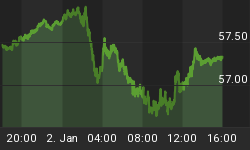Bonds did some more sliding last week, now down for the 6th week in a row. While the 'big' news was the better than expected employment data in the US - more on that and the Canadian data in the next section - I wanted to focus a tad more on the recent consumer related news. The latest figures show that July Vehicle Sales in the USA were reported at 20.9 million vehicles. Guess how many of them vehicles were bought on credit? Well, I would venture to guess most of them. And that after June Consumer Credit exploded by 14.5 billion. I just can't wait to see the July data-point in this series. And meanwhile the savings rate is officially at ZERO for the second time since the Great Depression. But the experts tell us that it just doesn't matter, because household wealth continues to rocket with housing values increasing at a 14% annual clip according to the latest figures. So as long as the music doesn't stop in the housing arena, the consumer will continue to dance in the streets. Oh yes, and did you all see Baidu.com go ballistic on Friday? I suppose consumers went on a borrowing binge in June in anticipation of buying the Baidu IPO on Friday. And did I mention that on Tuesday the Fed is going to raise rates another 25 basis points - from 3.25 to 3.50%? All that floating rate credit ain't getting cheaper Mr. and Ms. Consumer. The old rubber band keeps stretching, and with every day of over-extension we are getting closer to the time when it will either break or snap back. And that will not be pretty.
NOTEWORTHY: The economic calendar was mostly positive again last week. The ISM surveys are telling us that both services and manufacturing are in a solid expansion. The employment data was stronger than expected, with positive revisions for the previous releases. Not so in Canada, where overall employment was way below the 20k job creation that was expected, but what is worse is that full time employment actually declined 2.5k. In the previous issue I ranted about the tough spot that the Canadian manufacturers are in as they have yet to adjust to the substantially stronger Canadian currency. The Canadian manufacturing sector lost 25k jobs again last month. To put this into perspective for our little American friends, that would be the equivalent of losing 250 thousand manufacturing jobs in one month, relative to the size of the US economy. Can you imagine the panic and horror caused by such a figure in the US? The Canadian economy is completely bi-polarized: the oil-patch rocks while the manufacturing sector just sucks. Why the Bank of Canada is fixin' to raise rates under these circumstances is completely beyond me. The upcoming week's schedule includes the Retail Sales, Trade Data and the Fed raising the Funds rate to 3.5% and a few bond auctions Monday, Wednesday and Thursday.
INFLUENCES: The latest Treasury market survey of all the Wall Street gurus is still predominantly bearish, looking for 4.65% on 10 year notes by year-end. The survey was not nearly as unanimous as the one at the beginning of the year. The 'smart money' commercials are still long 10 year note futures, but they cut back their positions from 165k contracts last week to 126k this week. This number is slightly positive for bonds. Seasonals are becoming quite positive into August. Bonds continue to give up ground and broke to new lows last week. The Long Bond Futures traded down to 114-01. I am looking for this level to provide solid support, and advise buying bonds at that level, if you have not already done so.
RATES: US Long Bond futures closed at 114-06, down a dollar and change this week, while the yield on the US 10-year note increased 11 basis points to 4.39%. The Canada - US 10 year spread was in 2 to -39 basis points as Canadian bond market participants are finally realizing that Canadian bonds are rather expensive relative to their US counterparts. The US-Canada 10 year yield spread did not quite trade to our targeted pick-up of 46 basis points or better last week. We will leave this trade proposal open for another week. The belly of the Canadian curve underperformed 4 basis points relative to the wings last week. Selling Canada 3.25% 12/2006 and Canada 5.75% 6/2033 to buy Canada 5.25% 6/2012 was at a pick-up of 37 basis points. Assuming an unchanged curve, considering a 3-month time horizon, the total return (including roll-down) for the Canada bonds maturing in 2012 and 2013 are the best value on the curve. In the long end, the Canada 8% bonds maturing on June 1, 2023 continue to be the cheapest issue on a relative basis.
CORPORATES: Corporate bond spreads were steady again last week. Long TransCanada Pipeline bonds were unchanged at 116, while long Ontario bonds were also 1 bp tighter at 44.5. A starter short in TRAPs was recommended at 102 in February 2004. Shorter maturity, quality corporates should be favoured over lower rated issues as I believe corporate spreads will continue to be under pressure. Any credit that is connected with the consumer and discretionary spending should be avoided. As a new recommendation we advised to sell 10 year Canadian Bank sub-debt at a spread of 58 bps over the 10 year Canada bond. This spread closed at 54 basis points on Friday - 1 basis point wider on the week.
BOTTOM LINE: Buy bonds on dips to the 114 level on the Long Bond future if you have not already done so and sell Canada 10 year bonds to buy US 10 year notes at 46 bps or better. An overweight position in the belly of the curve is still recommended for Canadian accounts. Short exposure for the corporate sector is advised. We recommended an increase in short corporate exposure recently.
















